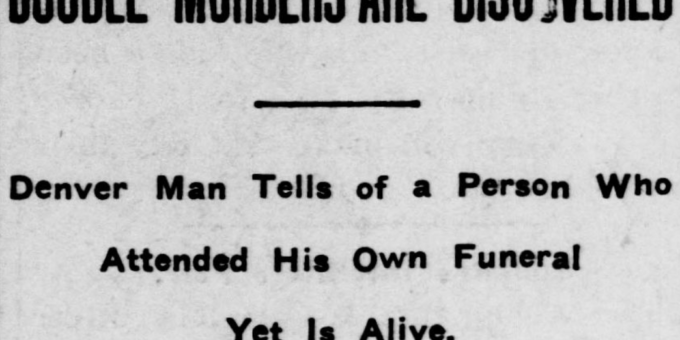
An interesting article that sparks a lot of speculation. It is about a man who may have murdered another man, put his clothes and pocket watch on the body so that when the remains were found, people thought it was him.
Double Murders Are Discovered
Fifteen years ago J. Martin McKay, now of Denver and custodian of the News-Times building here, assisted in the burial of a skeleton supposed to be that of Julius Leogo, a friend who had been in the News business office and today the two men met face to face.McKay recognized him in an instant but could scarcely believe he was not looking upon a ghost.
Leogo talked freely for a few minutes about his wanderings, but when questioned about how another person’s skeleton was mistaken for his own he became reticent and would not discuss the affair. He admitted he used the skeleton to fool his wife, whom he desired to get away from, but he would not tell whose it was.
He left soon after, promising to return, but he has not done so. Several persons saw him talking to McKay. He said he was staying at the Oxford hotel but he is not there.
The Second Crime
What was known as the Leogo murder created a sensation in Southern California about 15 years ago. Leogo left San Diego with a man whose name McKay does not know. The two men went to El Campo, across the Mexican line where McKay saw Leogo later. Then Leogo and his companion left on a prospecting trip, taking the wagon. Two months later the skeleton was found beside the wreckage of the wagon. An old silver watch beside it contained the name of Julius Leogo engraved thereon. The weather beaten clothes were also identified as those of Leogo. The skeleton was taken to San Diego. A bullet hole in the skull at the back of the right ear indicated murder. Mrs. Leogo identified the skeleton as that of her husband. It was interred in a little cemetery then used at San Diego. The coroner’s jury declared that it was the skeleton of Leogo and that he had been murdered.
McKaye believes Leogo has changed his name and disappeared fearing arrest on a charge of having murdered the man whose skeleton was found.
Source: The Evening statesman. (Walla Walla, Wash.), 22 Sept. 1906.

